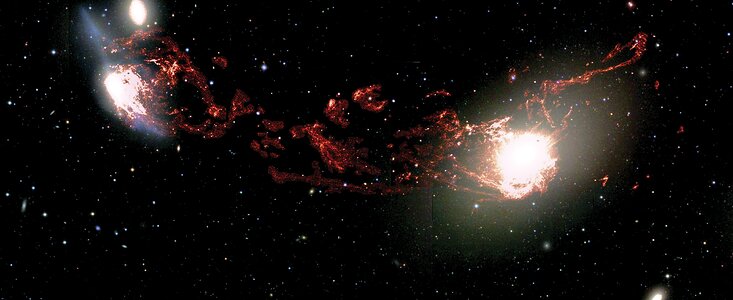Big Galaxy Collisions Can Stunt Star Formation
7 Octubre 2008
A deep new image of the Virgo cluster has revealed monumental tendrils of ionized hydrogen gas 400,000 light-years long connecting the elliptical galaxy M86 and the disturbed spiral galaxy NGC 4438.
Taken with the wide-field Mosaic imager on the National Science Foundation’s Mayall 4-meter telescope at Kitt Peak National Observatory, this Hydrogen-alpha image and related spectroscopic measurements of the filament provide striking evidence of a previously unsuspected high-speed collision between the two galaxies.
“Our data show that this system represents the nearest recent collision between a large elliptical galaxy and a large spiral,” said Jeffrey Kenney of Yale University, lead author of a paper to be published in a November 2008 issue of Astrophysical Journal Letters. “This discovery provides some of the clearest evidence yet for high-speed collisions between large galaxies, and it suggests that the consequences of such collisions are a plausible alternative to black holes in trying to explain the mystery of what process turns off star formation in the biggest galaxies.”
The Virgo cluster is located approximately 50 million light-years from Earth. Previous studies had noticed disturbed H-alpha gas around each of the two galaxies, but no connection from the two had been inferred. Indeed, some results have suggested that NGC 4438 collided with the small lenticular galaxy NGC 4435, but NGC 4435 has a much higher line-of-sight velocity as seen from Earth and appears undisturbed.
Spectroscopy of selected regions along the filament between M86 and NGC 4438, obtained with the Sparsepak Integral Field Unit instrument on the WIYN 3.5-meter telescope on Kitt Peak, shows a fairly smooth velocity gradient between the galaxies, supporting the collision scenario. There are no obvious stars in the filaments.
“The image shows what you can find if you look deep and wide, and we needed to do both to see the M86-NGC4438 complex,” Kenney explains.
As in most elliptical galaxies, most of the gas within M86 is extremely hot, and therefore radiates X-rays. The X-ray distribution in M86 is irregular and sports a long plume, which had previously been interpreted as a tail of gas which is being stripped by ram pressure as M86 falls into the intracluster medium of the Virgo cluster. The new H-alpha image from Kitt Peak suggests that most of the disturbances to the interstellar medium in M86 are instead due to the collision with NGC 4438.
A current mystery in astronomy is what causes the biggest galaxies in the Universe—which are primarily ellipticals, like M86—to stop forming stars. “Something needs to heat up the gas so it doesn’t cool and form stars,” Kenney says. “A number of recent studies suggest that energy from active galactic nuclei associated with supermassive black holes may do this, but our new study shows that gravitational interactions may also do the trick.”
Low-velocity collisions, especially between small- to medium-sized galaxies, often cause an increase in the local star formation rate, as the collisions tend to cause gas to concentrate in the galaxy centers. But in high velocity collisions (which happen naturally between large galaxies, since their large gravity pulls mass inward much faster), the kinetic energy of the collision can cause the gas to heat up so much that it cannot easily cool and form stars.
While not many galaxies suffer such extreme collisions as M86, most galaxies experience minor mergers and gas accretion events, and these may play a significant role in heating the galaxy’s gas. These more common but modest events are very hard to study, since their observational signatures are weak.
“The same physical processes occur in both strong and weak encounters, and by studying the observable effects in extreme cases like M86 we can learn about the role of gravity in the heating of galaxy gas, which appears to be quite significant,” Kenney adds.
Notas
Co-authors of the study include Yale graduate student Tomer Tal, Hugh Crowl from the University of Massachusetts, WIYN Observatory Director George Jacoby, and John Feldmeier of Youngstown State University.
Kitt Peak National Observatory is part of the National Optical Astronomy Observatory (NOAO), which is operated by the Association of Universities for Research in Astronomy (AURA) under a cooperative agreement with the National Science Foundation. The founding members of the WIYN Observatory partnership are the University of Wisconsin, Indiana University, Yale University, and NOAO.
Contactos
Douglas Isbell
Office of Public Affairs and Educational OutreachNational Optical Astronomy Observatory
Tel: 520/318-8230
Correo electrónico: disbell@noao.edu
About the Release
| Release No.: | noao0808 |
| Legacy ID: | NOAO 08-07 |
| Nombre: | M86, NGC 4438 |
| Facility: | WIYN 3.5-meter Telescope |



